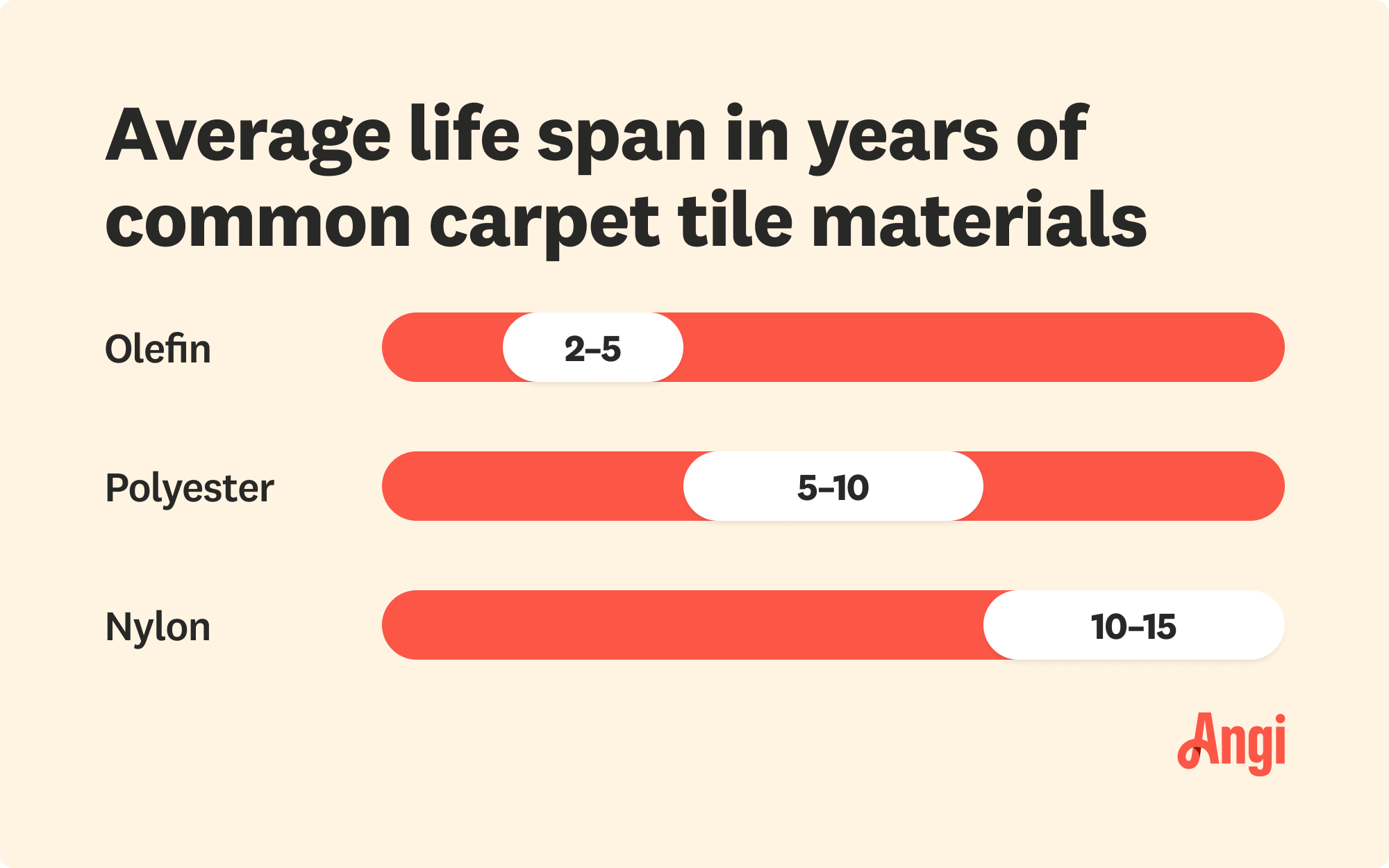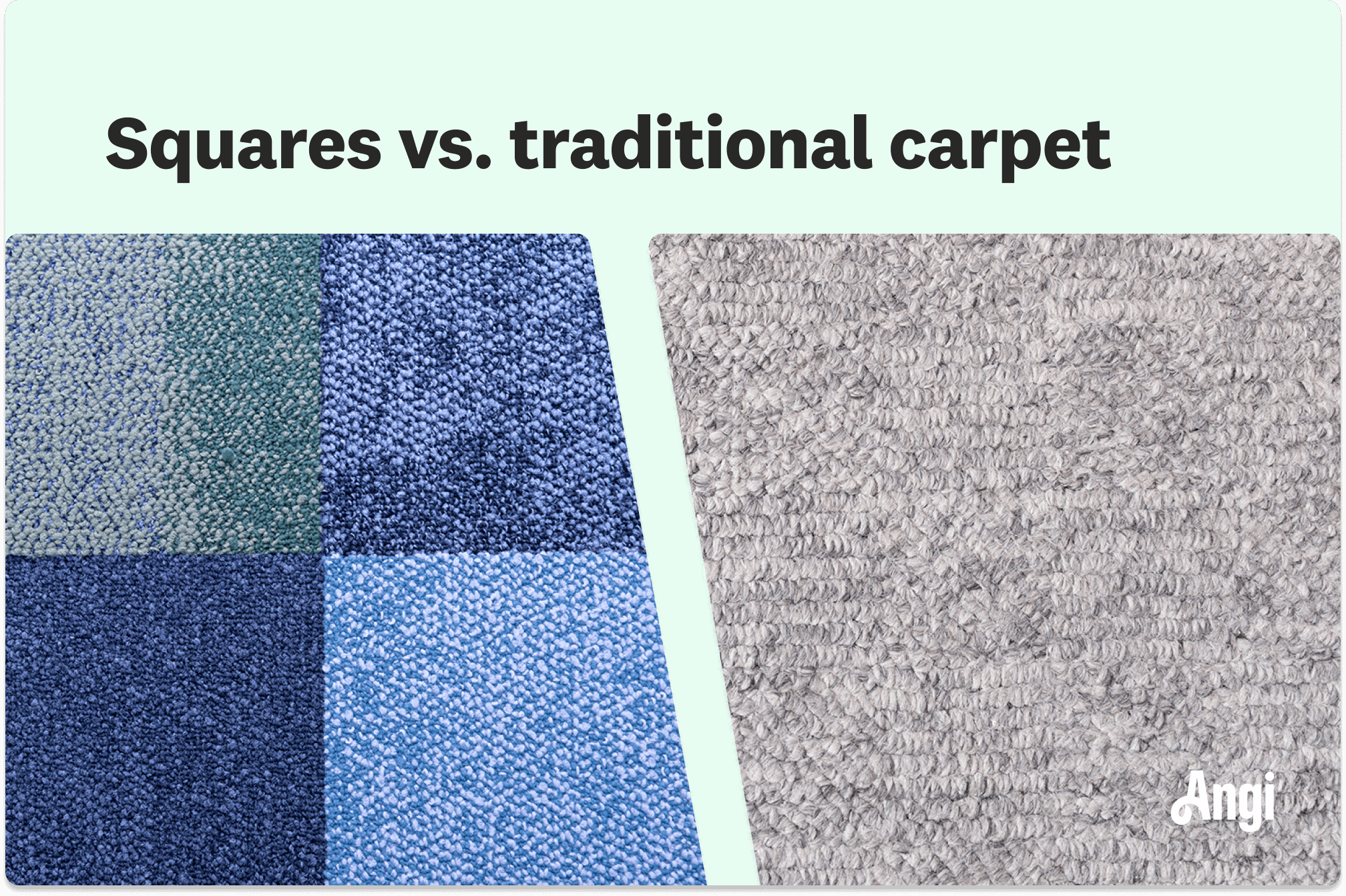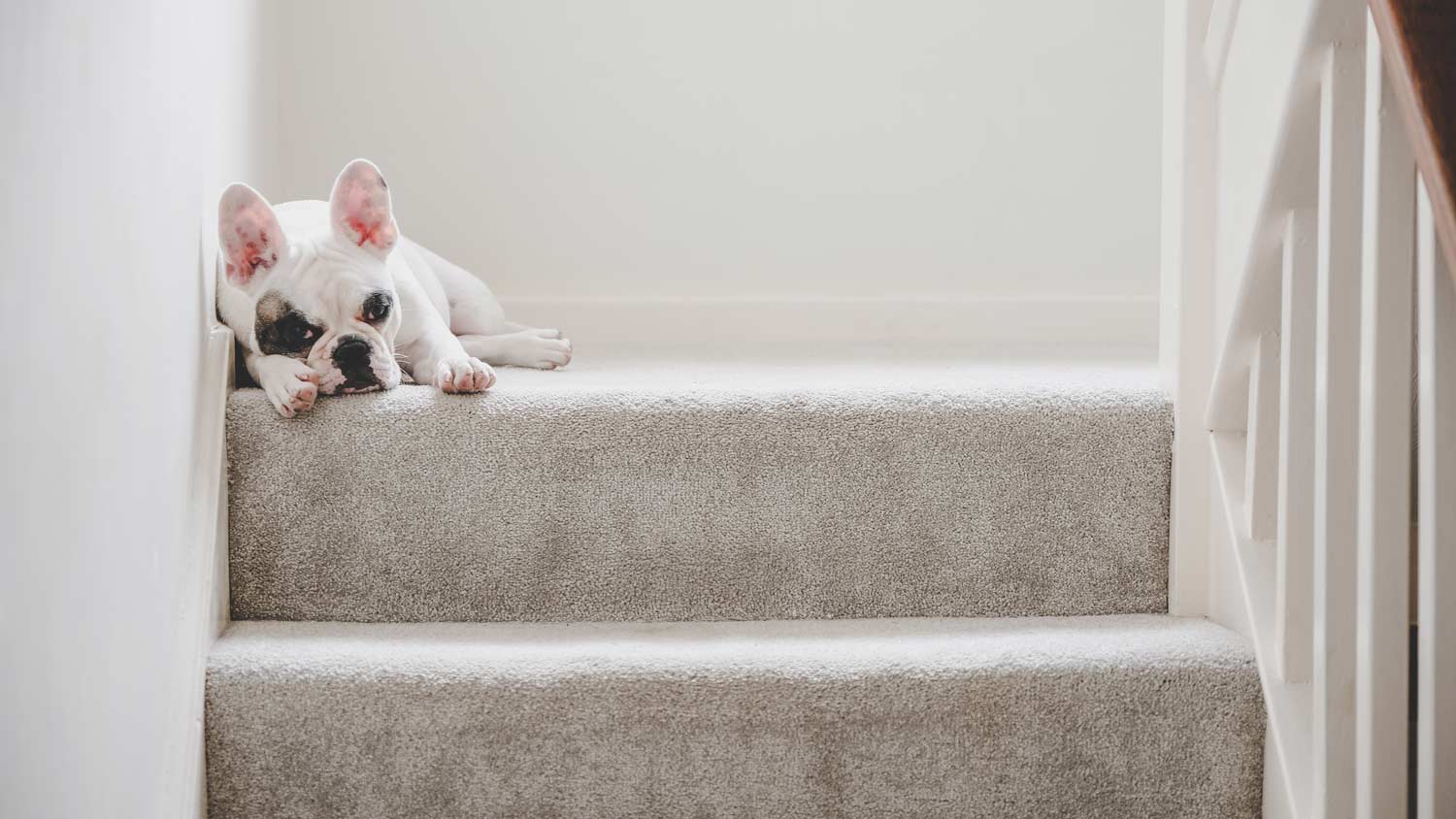
Carpet padding makes your carpet feel extra comfortable and protects your floors from damage, but how much does carpet padding cost? Let’s look at the numbers.
Installing carpet tiles costs an average of $920, with most people spending between $540 and $2,380. A pro can estimate the cost based on materials and size.


The biggest cost factor is the size of your space, and the cost varies significantly between single-room and whole-home installations.
Your material choice affects the price, with polyester and polypropylene tiles costing less per square foot than nylon tiles.
Installing your own carpet tile helps save on labor costs, but it will take time.
Additional costs may include carpet removal and subfloor preparation or repair.
Carpet tiles, also called carpet squares, offer many of the benefits of traditional carpet but with a lower price tag and a simpler installation process. The average carpet tile installation cost is $920, based on the dimensions of a medium-sized, 18-by-12-foot living room (216 square feet). However, costs range from $540 to $2,380, depending on the tile material and other factors.
Your total cost for this project will depend on a few factors, including how many rooms you’re carpeting, which carpet tiles you choose, and whether or not you have old carpeting to remove.
The size of your space is the most significant factor determining the overall cost of installing carpet tile. On average, you’ll pay between $2.50 and $11 per square foot for professional carpet tile installation, depending on the specific tiles you choose and the condition of your floor.
As you might expect, it costs much less to put carpet tiles in just one room—a kids’ playroom, for example—than in your entire home. Here are some examples of carpet tile costs per square foot (installed) based on various room and house sizes.
| Square Footage | Average Cost |
|---|---|
| 200 | $500–$2,200 |
| 400 | $1,000–$4,400 |
| 600 | $1,500–$6,600 |
| 800 | $2,000–$8,800 |
| 1,000 | $2,500–$11,000 |
| 2,000 | $5,000–$22,000 |

Like regular carpet, carpet tiles come in a variety of materials, with nylon and polyester being two of the most popular options. While they’re both types of synthetic carpet fiber, nylon is slightly more expensive than polyester. Some companies also sell polypropylene (also known as olefin) carpet tiles, which are similar in price to polyester.
The carpet tiles themselves cost between $1 and $5 per square foot (although certain styles may cost more), depending on the material. Here are the average costs for the most popular types of carpet tiles.
| Material | Average Cost per Square Foot |
|---|---|
| Polyester | $1–$3 |
| Polypropylene (olefin) | $1–$3 |
| Nylon | $2–$5 |
The style and construction of carpet tiles also affect pricing. Different weaving patterns and textures come with different levels of durability, appearance, and comfort underfoot.
Berber styles are more expensive, averaging between $2 and $4 per square foot. If you’re looking for a budget-friendly option, go for the basic twist, which costs between $1 and $3 per square foot.
| Carpet Tile Material | Average Cost (Per Square Foot) |
|---|---|
| Berber | $2–$4 |
| Pattern | $3–$4 |
| Texture | $2–$3 |
| Twist | $1–$3 |
The carpet tiles themselves make up a big chunk of your budget, but a few other expenses can add to your total project cost. You’ll need to factor in labor charges, removal of existing flooring, subfloor preparation, and other services.
The cost of hiring a professional to install carpet tiles will vary. Some companies offer free installation if you buy the tiles from them (although there may be a minimum spend requirement), while others may charge $0.50 to $1 per square foot for installation.
If you’re curious about labor costs in your area, contact a local carpet installer (or multiple installers) to find out what they charge.
If you’re replacing regular carpeting with carpet tiles, you’ll have to get rid of the existing carpet first. Otherwise, you can install carpet tiles directly over the subfloor as long as it’s in good condition (more on that below).
Carpet removal costs range from $0.50 to $5 per square foot. Contractors may charge more to remove carpet that’s glued down (rather than stapled) because it’s harder to pull up without damaging the floors underneath.
The cost of carpet disposal is often included with removal, but you’ll want to confirm this with your carpet removal company. If you remove the carpet yourself, you may be able to arrange disposal for $0.40 to $0.50 per square foot.
| Square Footage | Average Cost |
|---|---|
| 200 | $100–$500 |
| 400 | $200–$2,000 |
| 600 | $300–$3,000 |
| 800 | $400–$4,000 |
| 1,000 | $500–$5,000 |
| 2,000 | $1,000–$10,000 |
Before an installer can start laying your carpet tiles, they’ll need to make sure that your subfloor is clean, dry, level, and structurally sound. This can involve pulling out nails or staples, removing dirt and grime, and applying a coat of primer.
If there are any issues (for example, cracks or gaps in the subfloor), you’ll need to account for the cost of subfloor repairs, which range from $2 to $10 per square foot. Or, if the damage is more serious, your contractor may decide that you need a new subfloor. On average, replacing a subfloor costs between $3 and $10 per square foot.
Carpet padding provides cushioning underneath carpet installations. However, most carpet tiles don’t require carpet padding and have built-in backing for stability. This is one of the advantages of choosing carpet tiles over regular carpet.
In some cases, you might want to add a thin underlayment for extra comfort, sound dampening, or moisture protection, especially in basements. Carpet padding costs an average of $510 but ranges from $170 to $850, depending on the scope of your project.
Carpet is the most forgiving for subfloor imperfections. It can be laid over plywood seams, divots, or raised areas, as the thickness of the padding and carpet will help hide these flaws.
Some flooring pros may move furniture out of the installation area, but many will not. It’s a good question to ask potential pros when collecting quotes—they may offer the service at an extra cost. If you need help moving heavy items within your home to clear the floor, consider hiring professional movers. These pros can transport heavy items to your garage, basement, or storage facility. Depending on your moving needs, prices range from $70 to $400.
Hiring a local carpet installation pro costs between $0.50 and $1.00 per square foot. Calling a carpet installer to put in carpet tiles will speed up the process and allow you to enjoy your plush carpet sooner. Some carpet companies offer free installation when you purchase their carpet, so be sure to compare quotes and services.
Hiring a carpet pro is the best way to get your carpet installed correctly in your home. Here’s why:
Professionals bring the proper tools, saving you from buying tools that you may only use once or twice.
Experts can dispose of the old flooring material and handle the cleanup.
Professionally installed carpet tiles will create a seamless look in your space.
Carpet tile pros can also handle necessary subfloor repairs.
Reputable installers can help you choose the best carpet padding for your home and lifestyle.
If you want to help the carpet tile installation process go smoothly, you can do the following:
Clearing all of the furniture out of the room and putting it back after the installation
Removing the old flooring material and disposing of it yourself
Doing your research to decide which material and padding you want to go with
While installing carpet tile yourself is the most obvious strategy for saving money on this project, there are other ways to cut costs, as well—even if you hire a pro for the job. Here are a few tips to keep your budget on track:
Move furniture: Before you can install carpet tiles in a room, you need to make sure that the space is empty and clear of furniture. You may be able to reduce labor costs by handling this yourself.
Remove old carpet: Similarly, you need to pull up and dispose of your old carpet before a pro can lay new tiles. If you’re willing to roll up your sleeves, you can remove carpet yourself in about an hour per room—just let your contractor know ahead of time.
Opt for less-expensive materials: When you’re re-carpeting an entire home, the material costs can add up quickly. To keep expenses down, look for polyester or polypropylene tiles, which are more affordable than nylon.
Compare prices: Shopping around and getting quotes from multiple carpet companies can help you get the best deal on your carpet tile installation. Buying carpet at the right time of year may also help you save money.

Installing carpet costs between $3 and $11 per square foot while carpet tile prices start around $2.50 per square foot, climbing to $11 or higher depending on the style and quality. Other considerations, like adding carpet padding, will impact what you decide to install. Tufted carpet, also called broadloom, is great for hiding issues with the floor itself because of its seamless appearance.
Conversely, carpet tiles are relatively easy to DIY, so you can save on labor costs with this option if you’re up to the task. Perhaps best of all, if a tile is damaged, it's a snap to replace it without disrupting the tiles around it.
Be prepared to discuss the carpet tile materials and padding options you want with your carpet installer.
Have an idea of the room's size so that you can discuss the pricing.
Ask about the cost of subfloor repairs and discuss any issues you've noticed.
Home is the most important place on earth, which is why Angi has helped more than 150 million homeowners transform their houses into homes they adore. To help homeowners with their next project, Angi provides readers with the most accurate cost data and upholds strict editorial standards. We extensively research project costs to develop the pricing data you see, so you can make the best decisions for you and your home. We rely on reputable sources, including the U.S. Bureau of Labor Statistics, academic journals, market studies, and interviews with industry experts—all to ensure our prices reflect real-world projects.
Want to help us improve our cost data? Send us a recent project quote to [email protected]. Quotes and personal information will not be shared publicly.
From average costs to expert advice, get all the answers you need to get your job done.

Carpet padding makes your carpet feel extra comfortable and protects your floors from damage, but how much does carpet padding cost? Let’s look at the numbers.

Discover how much carpet replacement costs based on factors like the project size, the carpet material, and the labor required.

The cost to carpet stairs depends on the number of stairs, material choice, and staircase type. Read on to calculate your project expenses

Many homeowners want to know who installs carpet. Discover the best experts to work with, guaranteeing soft and cozy results.

Is moisture barrier carpet padding worth it? This guide explains how it works, where it's a good idea, and when it's not the best option for your home.

Slippery carpet stairs could get you down—literally. Fortunately, these five tips will keep your steps nice and steady, even if you keep the carpet.